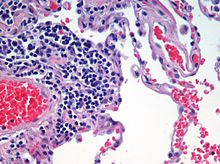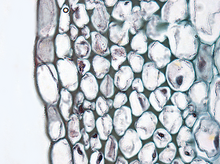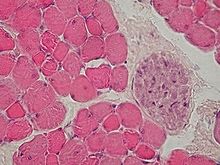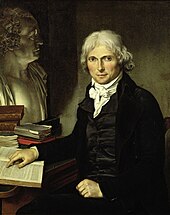Tissue (biology)
This article needs additional citations for verification. (February 2019) |

| Part of a series on |
| Biology |
|---|
In biology, tissue is an assembly of similar cells and their extracellular matrix from the same embryonic origin that together carry out a specific function.[1][2] Tissues occupy a biological organizational level between cells and a complete organ. Accordingly, organs are formed by the functional grouping together of multiple tissues.[3]
Cells < Tissue < Organ < Organ System < Organism
The English word "tissue" derives from the French word "tissu", the past participle of the verb tisser, "to weave".
The study of tissues is known as
Plant tissue
In plant anatomy, tissues are categorized broadly into three tissue systems: the epidermis, the ground tissue, and the vascular tissue.
- Epidermis – Cells forming the outer surface of the leaves and of the young plant body.
- Vascular tissue – The primary components of vascular tissue are the xylem and phloem. These transport fluids and nutrients internally.
- Ground tissue – Ground tissue is less differentiated than other tissues. Ground tissue manufactures nutrients by photosynthesis and stores reserve nutrients.
Plant tissues can also be divided differently into two types:
- Meristematic tissues
- Permanent tissues.
Meristematic tissue
Meristematic tissue consists of actively dividing cells and leads to increase in length and thickness of the plant. The primary growth of a plant occurs only in certain specific regions, such as in the tips of stems or roots. It is in these regions that meristematic tissue is present. Cells of this type of tissue are roughly spherical or polyhedral to rectangular in shape, with thin cell walls. New cells produced by meristem are initially those of meristem itself, but as the new cells grow and mature, their characteristics slowly change and they become differentiated as components of meristematic tissue, being classified as:
There are two types of meristematic Tissue
1.Primary meristem.
2.Secondary meristem.
- Apical meristem : Present at the growing tips of stems and roots, they increase the length of the stem and root. They form growing parts at the apices of roots and stems and are responsible for the increase in length, also called primary growth. This meristem is responsible for the linear growth of an organ.
- Lateral meristem: Cells which mainly divide in one plane and cause the organ to increase in diameter and girth. Lateral meristem usually occurs beneath the bark of the tree as cork cambium and in vascular bundles of dicotyledons as vascular cambium. The activity of this cambium forms secondary growth.
- Intercalary meristem: Located between permanent tissues, it is usually present at the base of the node, internode, and on leaf base. They are responsible for growth in length of the plant and increasing the size of the internode. They result in branch formation and growth.
The cells of meristematic tissue are similar in structure and have a thin and elastic primary cell wall made of
Meristematic tissue cells have a large nucleus with small or no vacuoles because they have no need to store anything, as opposed to their function of multiplying and increasing the girth and length of the plant, with no intercellular spaces.
Permanent tissues
Permanent tissues may be defined as a group of living or dead cells formed by meristematic tissue and have lost their ability to divide and have permanently placed at fixed positions in the plant body. Meristematic tissues that take up a specific role lose the ability to divide. This process of taking up a permanent shape, size and a function is called cellular differentiation. Cells of meristematic tissue differentiate to form different types of permanent tissues. There are 2 types of permanent tissues:
- simple permanent tissues
- complex permanent tissues
Simple permanent tissue
Simple permanent tissue is a group of cells which are similar in origin, structure, and function. They are of three types:
- Parenchyma
- Collenchyma
- Sclerenchyma
Parenchyma
Collenchyma

Collenchymatous tissue acts as a supporting tissue in stems of young plants. It provides mechanical support, elasticity, and tensile strength to the plant body. It helps in manufacturing sugar and storing it as starch. It is present in the margin of leaves and resists tearing effect of the wind.
Sclerenchyma
Sclerenchyma (Greek, Sclerous means hard and enchyma means infusion) consists of thick-walled, dead cells and protoplasm is negligible. These cells have hard and extremely thick secondary walls due to uniform distribution and high secretion of lignin and have a function of providing mechanical support. They do not have inter-molecular space between them. Lignin deposition is so thick that the cell walls become strong, rigid and impermeable to water which is also known as a stone cell or sclereids. These tissues are mainly of two types: sclerenchyma fiber and sclereids. Sclerenchyma fiber cells have a narrow lumen and are long, narrow and unicellular. Fibers are elongated cells that are strong and flexible, often used in ropes. Sclereids have extremely thick cell walls and are brittle, and are found in nutshells and legumes.
Epidermis
The entire surface of the plant consists of a single layer of cells called epidermis or surface tissue. The entire surface of the plant has this outer layer of the epidermis. Hence it is also called surface tissue. Most of the epidermal cells are relatively flat. The outer and lateral walls of the cell are often thicker than the inner walls. The cells form a continuous sheet without intercellular spaces. It protects all parts of the plant. The outer epidermis is coated with a waxy thick layer called cutin which prevents loss of water. The epidermis also consists of
Complex permanent tissue
The complex permanent tissue consists of more than one type of cells having a common origin which work together as a unit. Complex tissues are mainly concerned with the transportation of mineral nutrients, organic solutes (food materials), and water. That's why it is also known as conducting and vascular tissue. The common types of complex permanent tissue are:
Xylem and phloem together form vascular bundles.
Xylem
Xylem (Greek, xylos = wood) serves as a chief conducting tissue of vascular plants. It is responsible for the conduction of water and inorganic solutes. Xylem consists of four kinds of cells:

Xylem tissue is organised in a tube-like fashion along the main axes of stems and roots. It consists of a combination of parenchyma cells, fibers, vessels, tracheids, and ray cells. Longer tubes made up of individual cellssels tracheids, while vessel members are open at each end. Internally, there may be bars of wall material extending across the open space. These cells are joined end to end to form long tubes. Vessel members and tracheids are dead at maturity. Tracheids have thick secondary cell walls and are tapered at the ends. They do not have end openings such as the vessels. The end overlap with each other, with pairs of pits present. The pit pairs allow water to pass from cell to cell.
Though most conduction in xylem tissue is vertical, lateral conduction along the diameter of a stem is facilitated via rays.[citation needed] Rays are horizontal rows of long-living parenchyma cells that arise out of the vascular cambium.
Phloem
Phloem consists of:
- Sieve tube
- Companion cell
- Phloem fiber
- Phloem parenchyma.
Phloem is an equally important plant tissue as it also is part of the 'plumbing system' of a plant. Primarily, phloem carries dissolved food substances throughout the plant. This conduction system is composed of sieve-tube member and companion cells, that are without secondary walls. The parent cells of the vascular cambium produce both xylem and phloem. This usually also includes fibers, parenchyma and ray cells. Sieve tubes are formed from sieve-tube members laid end to end. The end walls, unlike vessel members in xylem, do not have openings. The end walls, however, are full of small pores where cytoplasm extends from cell to cell. These porous connections are called sieve plates. In spite of the fact that their cytoplasm is actively involved in the conduction of food materials, sieve-tube members do not have nuclei at maturity. It is the companion cells that are nestled between sieve-tube members that function in some manner bringing about the conduction of food. Sieve-tube members that are alive contain a polymer called callose, a carbohydrate polymer, forming the callus pad/callus, the colourless substance that covers the sieve plate. Callose stays in solution as long as the cell contents are under pressure. Phloem transports food and materials in plants upwards and downwards as required.
Animal tissue
Animal tissues are grouped into four basic types:
The epithelium in all animals is derived from the
The connective tissue and the muscular are derived from the mesoderm. The nervous tissue is derived from the ectoderm.
Epithelial tissues
The epithelial tissues are formed by cells that cover the organ surfaces, such as the surface of
Functions of epithelial tissue:
- The principle function of epithelial tissues are covering and lining of free surface
- The cells of the body's surface form the outer layer of skin.
- Inside the body, epithelial cells form the lining of the mouth and alimentary canal and protect these organs.
- Epithelial tissues help in the elimination of waste.
- Epithelial tissues secrete enzymes and/or hormones in the form of glands.
- Some epithelial tissue perform secretory functions. They secrete a variety of substances including sweat, saliva, mucus, enzymes.
There are many kinds of epithelium, and nomenclature is somewhat variable. Most classification schemes combine a description of the cell-shape in the upper layer of the epithelium with a word denoting the number of layers: either simple (one layer of cells) or stratified (multiple layers of cells). However, other cellular features such as cilia may also be described in the classification system. Some common kinds of epithelium are listed below:
- Simple squamous (pavement) epithelium
- Simple cuboidal epithelium
- Simple Columnar epithelium
- Simple ciliated (pseudostratified) columnar epithelium
- Simple glandular columnar epithelium
- Stratified non-keratinized squamous epithelium
- Stratified keratinized epithelium
- Stratified transitional epithelium
Connective tissue
Connective tissues are made up of cells separated by non-living material, which is called an extracellular matrix. This matrix can be liquid or rigid. For example, blood contains plasma as its matrix and bone's matrix is rigid. Connective tissue gives shape to organs and holds them in place. Blood, bone, tendon, ligament, adipose, and areolar tissues are examples of connective tissues. One method of classifying connective tissues is to divide them into three types: fibrous connective tissue, skeletal connective tissue, and fluid connective tissue.
Muscle tissue

Nervous tissue
Cells comprising the central nervous system and peripheral nervous system are classified as nervous (or neural) tissue. In the central nervous system, neural tissues form the brain and spinal cord. In the peripheral nervous system, neural tissues form the cranial nerves and spinal nerves, inclusive of the motor neurons.
Mineralized tissues
Mineralized tissues are biological tissues that incorporate minerals into soft matrices. Such tissues may be found in both plants and animals.
History

See also
- Generative tissue – Type of material used in medicine
- Laser capture microdissection – dissection on a microscopic scale with the help of a laser
- Tissue microarray – device for analysing many histological tissue samples
- Tissue stress
References
- PMID 22687222.
- S2CID 45712227.
- ISBN 978-1-947172-04-3. Archivedfrom the original on 2023-03-24. Retrieved 14 May 2023.
- ISBN 978-1451187427.
- ISBN 978-81-315-0104-7.)
{{cite book}}: CS1 maint: multiple names: authors list (link - doi:10.13070/rs.en.2.1283 (inactive 31 January 2024). Archived from the original on April 13, 2021. Retrieved August 14, 2021.)
{{cite journal}}: CS1 maint: DOI inactive as of January 2024 (link - ^ "Scientist of the Day: Xavier Bichat". Linda Hall Library. November 14, 2018. Archived from the original on May 23, 2020. Retrieved August 14, 2021.
- ^ Roeckelein 1998, p. 78
Sources
- Raven, Peter H., Evert, Ray F., & Eichhorn, Susan E. (1986). Biology of Plants (4th ed.). New York: Worth Publishers. ISBN 087901315X.
- Roeckelein, Jon E. (1998). Dictionary of Theories, Laws, and Concepts in Psychology. Greenwood Publishing Group. ISBN 978-0313304606. Retrieved 1 January 2013.
External links
 Media related to Biological tissues at Wikimedia Commons
Media related to Biological tissues at Wikimedia Commons- List of tissues in ExPASy
